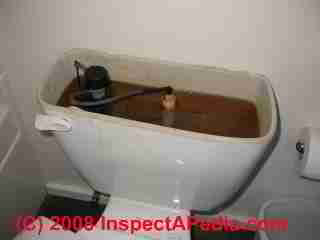 Where Find Emergency Drinking Water
Where Find Emergency Drinking Water
in Buildings After a Flood, Fire, Earthquake, or Hurricane
- POST a QUESTION or COMMENT about how to find sources of safe drinking water in an emergency
Where to find drinking water in an emergency:
This emergency drinking water source bulletin outlines possible places to obtain safe drinking water in an emergency following a disaster such as an earthquake, flood, or fire and before rescue workers have arrived.
Our photo at page top shows some brownish water in a toilet tank: actually the water was fine, the stain was from iron and rust in the original water supply - materials accumulated on the interior of the toilet tank. The water we removed was clear and sanitary.
InspectAPedia tolerates no conflicts of interest. We have no relationship with advertisers, products, or services discussed at this website.
- Daniel Friedman, Publisher/Editor/Author - See WHO ARE WE?
Get Emergency Drinking Water after Area Flooding, Hurricanes, Earthquakes, Fires
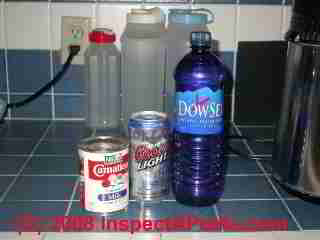 Some of the water sources listed below may be considered as desperate measures appropriate for people trapped in a building or those whom emergency relief workers have been unable to reach.
Some of the water sources listed below may be considered as desperate measures appropriate for people trapped in a building or those whom emergency relief workers have been unable to reach.
Watch out: before entering a building that has been affected by a disaster such as fire, earthquake, or flood,
see BUILDING ENTRY PROCEDURE AFTER FLOODING for some safety warnings for occupants, building owners, or volunteers who may find themselves indoors in a disaster area and without immediate assistance from rescue workers or other experts.
How to obtain emergency drinking water after flooding:
- Municipal water supply: try turning on the tap at a clean sink in the building; after some storms, fires, and even earthquakes, the public water supply may be operating in some areas.
Watch out: But do not assume that municipal water is safe to drink without boiling or disinfecting it until you are told that it's ok. The water supply source, pipes, or other system components may have been flooded and contaminated.
[Click to enlarge any image]
- Private well water: do not assume that private well water is sanitary and ok to drink even after flood waters have subsided. If the well and/or water equipment such as water tanks, piping, pumps, have been submerged, it is likely that repair and equipment cleaning/sanitizing are needed.
FLOOD CONTAMINATED WELL RESTORE & PROTECT - water from flooded wells is not safe to drink - how to clean and restore a flood-polluted water well
See WELL CHLORINATION SHOCKING PROCEDURE
and see WATER TESTS for CONTAMINANTS - Bottled water: if un-opened bottled water is available it should be safe to drink, but if the bottles were flooded it will be necessary to clean and disinfect the bottle exterior before opening.
- Bottled or canned juices or foods: sealed food containers such as cans or bottles of juice, soup, fruits, vegetables, should contain liquids that are safe to drink provided you make sure to clean and sanitize the container before opening it.
- Condensation of fresh water on cool surfaces has been collected and used as a survival aid in some circumstances. Do not however drink air conditioner condensate, dehumidifier condensate, or humidifier tank water - these are usually contaminated with bacteria.
- Distilled water: if you have electrical power and a home water distiller such as shown in our photo, this equipment can produce a limited quantity of safe drinking water.
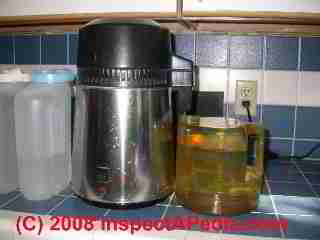
The yellow color you see in the container at right is due to discolored plastic - the water in the container, produced by the distiller, was clear and sanitary.
Camping suppliers provide portable water purification equipment that does not require electrical power, such as pumps using ceramic filters.
Be sure the containers used to collect the distilled water are sanitary. - Human urine as a water source for emergency survival has been used by people trapped in mines, and has made a life-or-death difference for trapped miners in some instances
- Ice: remaining ice, if the disaster event has been brief, water may be available from melting ice cubes.
- Neighboring properties: if a close-by neighboring property has safe sanitary drinking water you may be able to obtain a building water supply for your own home by connecting the two buildings together using a garden hose.
Details are at GARDEN HOSE for TEMPORARY WATER SUPPLY - Rainwater: if rain continues to fall, use a clean container to collect rainwater, possibly from a downspout; but that water should not be considered safe for drinking before it has been sterilized, because it has run over a building rooftop and through possibly unsanitary gutters and downspouts.
- Rooftop water tanks and cisterns may be available and are a good source of potable water in most cases as the tanks are more likely to have remained above floodwaters on taller buildings.

- Sanitize other emergency drinking water sources: if you have to collect emergency drinking water from other water sources not listed here it may require sanitizing or disinfection before it is safe to drink.
See SANITIZE DRINKING WATER in this article or for a complete list of emergency water purification or disinfection methods
Also see DRINKING WATER EMERGENCY PURIFICATION - home. - Shower pipes as an emergency drinking water source:
There may be a small volume of water remaining in a bath shower vertical pipe that will drain back through the tub spout in the upper level of a building that was not flooded.
Place a clean container below a clean tub spout and open the diverter that switches water between the tub spout and the shower head.
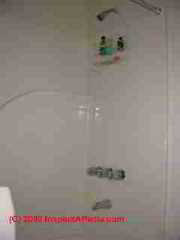
If the shower was last used with the diverter in that position, a small amount of water may remain in the shower pipe.
Unfortunately this is a desperate measure - the total volume of water in the shower riser pipe will be small. Possibly there you can find and drain other building pipes that were above the flood level to find additional water. - Toilets & Showers as an emergency drinking water source: It may be possible to salvage water from the toilet flush-tank if the toilet was above floodwaters and has not been flooded or buried in debris.

The water in a toilet bowl should be assumed to be contaminated and would need to be boiled and disinfected before use. - Water heaters as a source of emergency drinking water: You may be able to obtain safe water from undamaged water heaters.
Even though the water heater in our photograph has been flooded, by working carefully to clean the water heater drain and to collect its water into a clean container, it may be possible to extract potable water from inside the water tank.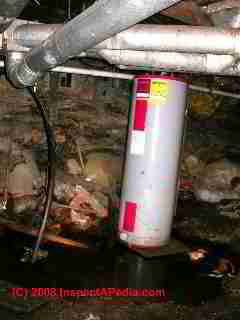
Be sure that a basement like the one we show is actually safe to enter before approaching the water tank, including safety from structural collapse, electrical shock, or toxins in the standing water on the floor.
Watch out: Never try to drain water from an electric water heater tank without being sure that the electrical power to the unit is off. Also turn off the fuel and power to gas or oil burners used to heat your water.
It will be easier to get water running out of the tank drain near the bottom of the water heater (that valve shown below the lower red panel in our photo), if you can let air into the water tank as water is running out.
This can be accomplished by opening a nearby hot water valve at a fixture higher than the water tank, or by opening the relief valve or a water shutoff valve air bleeder on the water tank itself.
Be sure that the drain used to remove such water has been cleaned and that you use a clean container to collect the water. If the water from the tank has been exposed to flood waters but looks clear it may still be contaminated and it may need to be boiled or disinfected.
Watch out: while taking potable water out of your water heater tank, do not let contaminated water run into the water heater tank from a contaminated water supply source such as unsafe municipal or private water wells contaminated by flood waters. Otherwise you're contaminating the water heater's water. This means that you want to
- turn off water entering the water heater at the control valve above the heater
- use the water heater relief valve as an air admittance valve to let air into the heater during draining
- check for leaks or replace the relief valve when later the water heater is restored to service
When you're ready to return the water heater to service, be sure to review WATER HEATER FLOOD DAMAGE REPAIR - can we save a flooded water heater? - Water pressure tanks: clean water may be available from inside private well system water pressure tanks.
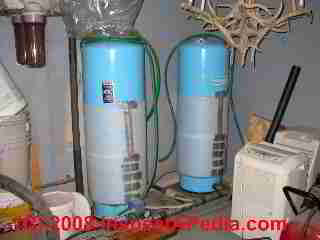
Watch out: But be careful; usually the pressure tank is located in a low building area which is likely to have been contaminated by floodwaters. If the pressure tank is sealed (and if you see that its gauge shows that the pressure tank is still under pressure), the water inside the tank may be uncontaminated.
The pair of water tanks shown here (it was a poor-recovery rate well that needed lots of in-house water storage) would provide nearly 50 gallons of potable water taken from the drain valve below the water pressure gauge at the left-most tank. - Wells that have been flooded: Watch out: drinking water wells that were inundated by flood waters should be pumped out and the water tested for purity before drinking.
See our well sterilization procedure using household bleach which is detailed at WELL SHOCK / CHLORINATION PROCEDURE. If in doubt, call your local public health authority. Ill health effects often occur when people drink water contaminated with bacteria and germs.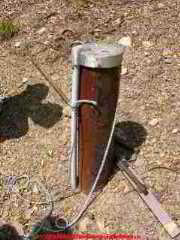
Advice If Using a Garden hose to collect emergency drinking water
Watch out: Do not collect water from a water heater, water pressure tank, or rooftop tank by using a garden hose that was contaminated by floodwaters unless the hose has been properly cleaned and disinfected.
See WELL CHLORINATION SHOCKING PROCEDURE.
Question: Can we run a hose from our neighbors tank to ours until fixed?
Sep 9, 2016 at 9:28 AM [anonymous by private email] wrote:
We are out if water New well to be drilled soon. Can we run a hose from our neighbors tank to ours until fixed? Problem being they have a different setting than ours. Ours is lower will we blow the bladder in our tank?
Reply: how to use a garden hose connected to a neighbor's house as a temporary water source
Yes.
As long as the neighbor's system pressure is under 70 psi you should be safe.
Because adding your home to the neighbor's well system will increase the water use of that well, you and your neighbor should also be sure that their own system is working properly lest the well be run dry or the pump damaged by short cycling on and off rapidly. Search Inspectapedia.com for SHORT CYCLING WELL PUMP if that problem occurs.
You could if you like also isolate your own pump and tank from the neighbor's water system as follows:
- Turn off power to y our pump and leave it off.
- Turn off the shutoff valve between your water pressure tank and the building.
- Connect the neighbor's water system to yours by connecting a garden hose from the closest neighbor's outdoor hose bibb or similar hose connection to the closest hose bibb, laundry cold water hookup or similar hose connection on your house. To make this connection you'll need buy male-to-female hose adapter or to use a short section of washing machine hose to connect from the outlet end of the garden hose to the outdoor hose bibb, spigot or similar fitting on your home.
- Flush the hose thoroughly before drinking water that passes through it, or boil drinking water if you're in any doubt about the safety of the neighbor's water supply.
It is also possible to disinfect a suspect garden hose by filling it with a bleach solution, leaving the hose to sit for 24 hours.
Watch out: if your home has been submerged by floodwaters then its water supply piping, fixtures, faucets, outdoor hose faucets, etc. may have been contaminated by floodwaters.
Those should be sanitized by disinfection before using them for drinking water and before connecting your building to another one for temporary water, since backflow from your building could also cross-contaminate the neighboring building.
Is There Lead in Your Garden Hose Used for Drinking Water?
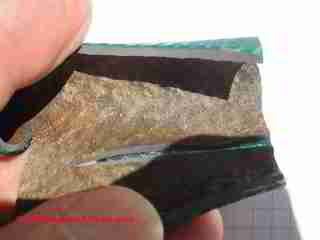
- Is there lead in your garden hose? People may be inclined to drink water from a garden hose for several reasons: it's available, you're hot, outdoors, thirsty, or you are priming a well pump
See WELL PUMP PRIMING PROCEDURE
or making an emergency water hook-up to a neighbor's house because your water supply has been lost
See WATER PRESSURE PUMP REPAIR GUIDE
Watch out: don't assume that the interior of a garden hose is sanitary or that water run through an ordinary garden hose is safe to drink.
Also some garden hoses contain lead - do not drink water from a garden hose unless you know that yours is not a lead-containing hose. If you are purchasing a new garden hose, check the label. - Some garden hose product labels indicate that the hose is safe for drinking. Others may indicate that the hose should not be used for drinking.
Unfortunately still other hoses are simply not labeled - we won't know about any chemical or lead hazards from drinking from such a hose without testing. - The lead hazard in a garden hose, as with possible lead hazards from lead plumbing or lead-solder-based copper pipe connections, depends on several variables including how long water has been resting inside the hose (longer absorbs more lead if lead is present), on the chemistry of your water supply (more aggressive may leach out more lead), and of course on the lead levels in the source: hose, pipe, or somewhere else.
- If you are in any doubt about the cleanliness of a garden hose being used for well pump priming or for an emergency water supply connection between buildings, sanitizing the hose or the plumbing system after it has been used.
- More information on lead in water supply piping is at LEAD in WATER, ACTION LEVELS and at LEAD IN DRINKING WATER, HOW to REDUCE,
and lead testing is discussed at LEAD TEST KIT for HOME USE.
How to Disinfect Water to Sanitize it For Drinking
 Watch out: Beware that most advice about purifying water, including the tips we have collected below, address only biological contaminants in water, such as bacteria.
Watch out: Beware that most advice about purifying water, including the tips we have collected below, address only biological contaminants in water, such as bacteria.
Also if your water supply, such as from a private well, has been contaminated with a high concentration of sewage (unlikely but possible) then ordinary levels of disinfection may not be sufficient.
In that case it's safer to find drinking water that is either already safe to drink or is less contaminated such as water salvaged from a water heater tank - as we discuss beginning at DRINKING WATER EMERGENCY SOURCES
Watch out:
But be careful. If your water supply has become contaminated by pesticides, heavy metals, or other chemicals that are spread by flood waters such as during the Houston Texas flooding in August & September 2017, simply disinfecting the water will not correct those unsafe conditions.
The principal methods used to purify water when camping or in an emergency include:
- Boil the water
- Use chlorine (bleach, sodium hypochlorite) to purify the water
- Use iodine or an iodine product to purify the water. Our photo (above/left) shows Potable Aqua® water purification germicidal tablets used for emergency drinking water supply.
- Use a water purifying pump such as models sold by camping equipment suppliers to purify the water=
Drinking Water Purification Procedures: are described in detail at DRINKING WATER - EMERGENCY PURIFICATION
and just below we list a complete catalog of approaches to disinfecting or sanitizing water for drinking.
...
...
Continue reading at DRINKING WATER EMERGENCY PURIFICATION - topic home, or select a topic from the closely-related articles below, or see the complete ARTICLE INDEX.
Or see these
Recommended Articles
- DRINKING WATER EMERGENCY PURIFICATION - home
- BLEACH DISINFECTANT for DRINKING WATER
- BOILING WATER for DRINKING
- CERAMIC FILTERS for WATER DISINFECTION
- CHLORINE DISINFECTANT for DRINKING WATER
- COLIFORM STANDARDS for DRINKING WATER
- COLLOIDAL SILVER for WATER DISINFECTION
- DRINKING WATER DISINFECTANT QUANTITY
- FILTERS for DRINKING WATER PURIFICATION
- GIARDIA in DRINKING WATER
- HYDROGEN PEROXIDE for WATER DISINFECTION
- IODINE for WATER DISINFECTION
- OZONE for WATER DISINFECTION
- SOLAR WATER DISINFECTION
- UV WATER DISINFECTION, PORTABLE
- VEGETABLE or PRODUCE DISINFECTION
- VINEGAR for PRODUCE or WATER DISINFECTION
- WATER DISINFECTANT CONCENTRATION
- WATER DISINFECTANT CONTACT TIME
- WATER DISINFECTION LIMITATIONS
Suggested citation for this web page
DRINKING WATER EMERGENCY SOURCES at InspectApedia.com - online encyclopedia of building & environmental inspection, testing, diagnosis, repair, & problem prevention advice.
Or see this
INDEX to RELATED ARTICLES: ARTICLE INDEX to WATER TREATMENT SYSTEMS
Or use the SEARCH BOX found below to Ask a Question or Search InspectApedia
Ask a Question or Search InspectApedia
Try the search box just below, or if you prefer, post a question or comment in the Comments box below and we will respond promptly.
Search the InspectApedia website
Note: appearance of your Comment below may be delayed: if your comment contains an image, photograph, web link, or text that looks to the software as if it might be a web link, your posting will appear after it has been approved by a moderator. Apologies for the delay.
Only one image can be added per comment but you can post as many comments, and therefore images, as you like.
You will not receive a notification when a response to your question has been posted.
Please bookmark this page to make it easy for you to check back for our response.
IF above you see "Comment Form is loading comments..." then COMMENT BOX - countable.ca / bawkbox.com IS NOT WORKING.
In any case you are welcome to send an email directly to us at InspectApedia.com at editor@inspectApedia.com
We'll reply to you directly. Please help us help you by noting, in your email, the URL of the InspectApedia page where you wanted to comment.
Citations & References
In addition to any citations in the article above, a full list is available on request.
- In addition to citations & references found in this article, see the research citations given at the end of the related articles found at our suggested
CONTINUE READING or RECOMMENDED ARTICLES.
- Carson, Dunlop & Associates Ltd., 120 Carlton Street Suite 407, Toronto ON M5A 4K2. Tel: (416) 964-9415 1-800-268-7070 Email: info@carsondunlop.com. Alan Carson is a past president of ASHI, the American Society of Home Inspectors.
Thanks to Alan Carson and Bob Dunlop, for permission for InspectAPedia to use text excerpts from The HOME REFERENCE BOOK - the Encyclopedia of Homes and to use illustrations from The ILLUSTRATED HOME .
Carson Dunlop Associates provides extensive home inspection education and report writing material. In gratitude we provide links to tsome Carson Dunlop Associates products and services.

